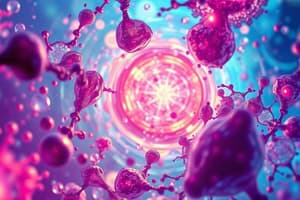Podcast
Questions and Answers
What is the basic structural and functional unit of all living organisms?
What is the basic structural and functional unit of all living organisms?
Cell
All cells are related by their descent from earlier cells.
All cells are related by their descent from earlier cells.
True
Which of the following is NOT a characteristic of all cells?
Which of the following is NOT a characteristic of all cells?
What is the name of the unbound region in prokaryotic cells where DNA is concentrated?
What is the name of the unbound region in prokaryotic cells where DNA is concentrated?
Signup and view all the answers
What type of cell contains membrane-enclosed organelles?
What type of cell contains membrane-enclosed organelles?
Signup and view all the answers
What is the name of the internal compartment of the ER?
What is the name of the internal compartment of the ER?
Signup and view all the answers
The smooth ER is involved in the synthesis of lipids, detoxification of drugs, and the storage of calcium ions.
The smooth ER is involved in the synthesis of lipids, detoxification of drugs, and the storage of calcium ions.
Signup and view all the answers
What is the primary function of the Golgi apparatus?
What is the primary function of the Golgi apparatus?
Signup and view all the answers
What are the membrane-enclosed sacs of hydrolytic enzymes called, found in the cytoplasm of animal cells?
What are the membrane-enclosed sacs of hydrolytic enzymes called, found in the cytoplasm of animal cells?
Signup and view all the answers
Lysosomes are involved in autophagy, the process of recycling the cell's own organelles and macromolecules.
Lysosomes are involved in autophagy, the process of recycling the cell's own organelles and macromolecules.
Signup and view all the answers
Which organelle is responsible for aerobic cellular respiration?
Which organelle is responsible for aerobic cellular respiration?
Signup and view all the answers
What are the highly folded structures within the inner membrane of mitochondria called?
What are the highly folded structures within the inner membrane of mitochondria called?
Signup and view all the answers
Chloroplasts are found in both plants and animal cells.
Chloroplasts are found in both plants and animal cells.
Signup and view all the answers
Which of the following is NOT a component of the cytoskeleton?
Which of the following is NOT a component of the cytoskeleton?
Signup and view all the answers
What is the name of the motor protein that moves vesicles along microtubules?
What is the name of the motor protein that moves vesicles along microtubules?
Signup and view all the answers
Cilia and flagella are both microtubule-containing extensions, but cilia are shorter and more numerous than flagella.
Cilia and flagella are both microtubule-containing extensions, but cilia are shorter and more numerous than flagella.
Signup and view all the answers
What is the name of the structure that anchors the nucleus and other organelles in a cell?
What is the name of the structure that anchors the nucleus and other organelles in a cell?
Signup and view all the answers
What is the name of the sticky carbohydrate layer found between primary cell walls of adjacent plant cells?
What is the name of the sticky carbohydrate layer found between primary cell walls of adjacent plant cells?
Signup and view all the answers
The extracellular matrix (ECM) is a meshwork of proteins and glycoproteins found around animal cells, but not plant cells.
The extracellular matrix (ECM) is a meshwork of proteins and glycoproteins found around animal cells, but not plant cells.
Signup and view all the answers
Which type of cell junction in animal cells prevents leakage of extracellular fluid?
Which type of cell junction in animal cells prevents leakage of extracellular fluid?
Signup and view all the answers
What is the function of gap junctions in animal cells?
What is the function of gap junctions in animal cells?
Signup and view all the answers
Plasmodesmata are specialized channels found in the cell walls of plant cells that allow for the passage of water, small solutes, and sometimes proteins and RNA.
Plasmodesmata are specialized channels found in the cell walls of plant cells that allow for the passage of water, small solutes, and sometimes proteins and RNA.
Signup and view all the answers
Study Notes
Cell Structure and Function
-
Cells are the fundamental units of life, found in all organisms, from single-celled bacteria to complex multicellular organisms. They exhibit a remarkable range of sizes, typically between 1-100 micrometers, though they are generally microscopic.
-
Cell size is fundamentally limited by the need for a large surface area-to-volume ratio. This ratio dictates the cell's ability to efficiently exchange materials with its environment (e.g. oxygen, nutrients, waste).
Microscopy Techniques
-
Light microscopes (LM) utilize visible light to magnify images of specimens, allowing for the visualization of the overall structure of cells. However, the resolution of LMs is often insufficient for detailed analysis of cell organelles.
-
Electron microscopes (EM) offer greater magnification and resolution compared to light microscopes, achieved by focusing beams of electrons rather than light. SEMs provide three-dimensional images of the specimen's surface, while TEMs allow for study of the specimen's internal structure.
-
Cell fractionation is a technique to isolate and study the functions of specific cell components (organelles) by separating cell components based on their density and size.
Cell Types
- Cells are broadly classified into prokaryotic and eukaryotic cells. Prokaryotic cells are simpler, lacking a nucleus or membrane-bound organelles (e.g., bacteria and archaea). Eukaryotic cells are more complex, possessing a nucleus and membrane-bound organelles (e.g., plants, animals, fungi, and protists).
Basic Cell Features
- All cells possess a plasma membrane that regulates the passage of materials in and out of the cell.
- Cytosol, a jelly-like fluid, suspends organelles and contains dissolved nutrients and ions within the cell (cytosol = fluid inside)
- DNA carries the genetic instructions for building proteins and is found in almost all cells (in prokaryotes in the nucleoid & eukaryotes in the nucleus)
- Ribosomes, for protein synthesis, are present in all cells, but are not membrane-bound.
Prokaryotic Cells
- Prokaryotic cells lack a nucleus and membrane-bound organelles, but possess a nucleoid region where their single circular chromosome is located.
- Their cell walls are commonly made of peptidoglycan, a rigid structure that supports and protects them,
Eukaryotic Cells
- Eukaryotic cells feature membrane-bound organelles, including a nucleus containing their multiple, linear chromosomes. This compartmentalization allows for various metabolic processes to occur simultaneously in a single cell.
Organelles
-
Nucleus: Contains most of the cell's DNA organized into chromosomes. The nuclear envelope, a double membrane, encloses the nucleus and regulates the passage of molecules in and out. The nucleolus within the nucleus is the site of ribosomal RNA (rRNA) synthesis.
-
Ribosomes: Sites of protein synthesis, either free in the cytoplasm or bound to the endoplasmic reticulum (ER).
-
Endoplasmic Reticulum (ER): A network of interconnected sacs and tubules.
-
Rough ER: Studded with ribosomes, it synthesizes proteins, including membrane proteins and secreted proteins. It is also a membrane factory for the cell, producing new membrane components as well as glycoproteins.
-
Smooth ER: Lacks ribosomes, synthesizes lipids, metabolizes carbohydrates, detoxifies drugs and poisons, stores calcium ions.
-
Golgi Apparatus: Modifies, sorts, and packages proteins received from the rough ER, often destined for secretion or for delivery to other organelles. It functions like a post office in the cell.
-
Lysosomes: Contain hydrolytic enzymes that digest macromolecules within the cell.
-
Vacuoles: Membrane-bound sacs involved in storage, waste disposal, water balance, and structural support (especially large central vacuoles in plant cells).
-
Mitochondria: Sites of cellular respiration, producing ATP (the cell's energy currency). Bound by a double membrane, with an inner membrane folded into cristae.
-
Chloroplasts: Sites of photosynthesis in plant cells and some protists. Bound by a double membrane, contain chlorophyll and stacks of thylakoids (grana).
-
Peroxisomes: Involved in various metabolic processes, producing and breaking down hydrogen peroxide.
Cytoskeleton
-
The cytoskeleton is a network of protein fibers that provides structural support and facilitates cell motility. It consists of microtubules (thickest), microfilaments (thinnest), and intermediate filaments (medium thickness).
-
Microtubules: Maintain cell shape, guide movement (cilia, flagella, chromosomes during cell division), and facilitate organelle movement. Dynein and kinesin are motor proteins that move along microtubules.
-
Microfilaments: Maintain cell shape (tension-bearing), influence cell motility (pseudopodia formation, muscle contraction), support microvilli, and involve in cytoplasmic streaming.
-
Intermediate filaments: Maintain cell shape (tension-bearing elements), anchorage of nucleus and other organelles, contribute to the nuclear lamina.
Extracellular Components
- Plant cells have rigid cell walls made of cellulose, providing structural support and protection against water pressure.
- Animal cells are surrounded by an extracellular matrix (ECM) composed of various proteins like collagen, providing structural support, cell signaling, and anchorage.
- Specialized cell junctions (plasmodesmata in plants and tight junctions, desmosomes, and gap junctions in animals) connect neighboring cells, facilitating communication and interaction.
Studying That Suits You
Use AI to generate personalized quizzes and flashcards to suit your learning preferences.
Description
Test your knowledge on cell structure, function, and microscopy techniques. This quiz covers fundamental concepts of cellular biology, including the size limits of cells and the use of light and electron microscopes. Improve your understanding of these essential biological principles.



